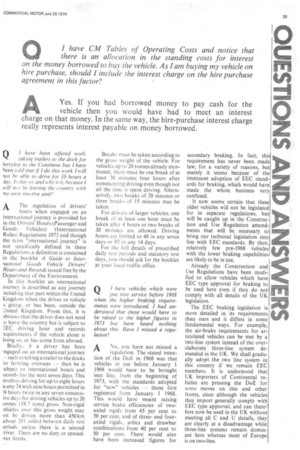Q I have been offered work taking trailers to the
Page 45

If you've noticed an error in this article please click here to report it so we can fix it.
dock for ferrying to the Continent but 1 have been told that if I do this work I will not he able to drive for 10 hours a. day. ls this s.o, and why is it, because 1 will not he leaving the country with my own tractive unit?
AThe regulation of drivers' hours when engaged on an international journey is provided for in the Drivers' Hours (Passenger and Goods Vehicles) (International Rules) Regulations 1973 and though the term "international journey" is not specifically defined in these Regulations a definition is contained in the booklet A Guide to International Goods Vehicle Drivers' Hours and Records issued free by the Department of the Environment.
In this booklet an international journey is described as any journey ncluding that part within the United Kingdom when the driver or vehicle s going, or has been, outside the United Kingdom. From this, it is )bvious that the driver does not need .o leave the country but is subject to EEC driving hour and records -equirements if the vehicle alone is loing so, or has come from abroad.
Briefly, if a driver has been :ngaged on an international journey — such as taking a trailerto the docks Or ferrying overseas — then he is ubject to international hours and ecords for the next seven days. This nvolves driving for up to eight hours n any 24 with nine hours permitted in A hours twice in any seven cOnsecuive days for driving vehicles up to 20 onnes (19.7 tons) gross. Non-rigid 'elides over this gross weight may lOt be driven More than 450 km about 281 miles) between daily rest leriods unless there is a second lriver. There are no duty or spreadiver limits. Breaks must be taken according to the gross weight of the vehicle. For vehicles up to 20 tonnes already mentioned, there must be one break of at least 30 minutes four hours after commencing driving even though not all the time is spent driving. Alternatively, two breaks of 20 minutes or three breaks of 15 minutes may be taken.
For drivers of larger vehicles, one break of at least one hour must be taken after 4 hours or two breaks of 30 minutes are allowed. Driving hours are limited to 48 in any seven days or 92 in any 14 days.
For the lint details of prescribed daily rest periods and statutory rest days, you should ask for the booklet at your local traffic office.
































































































